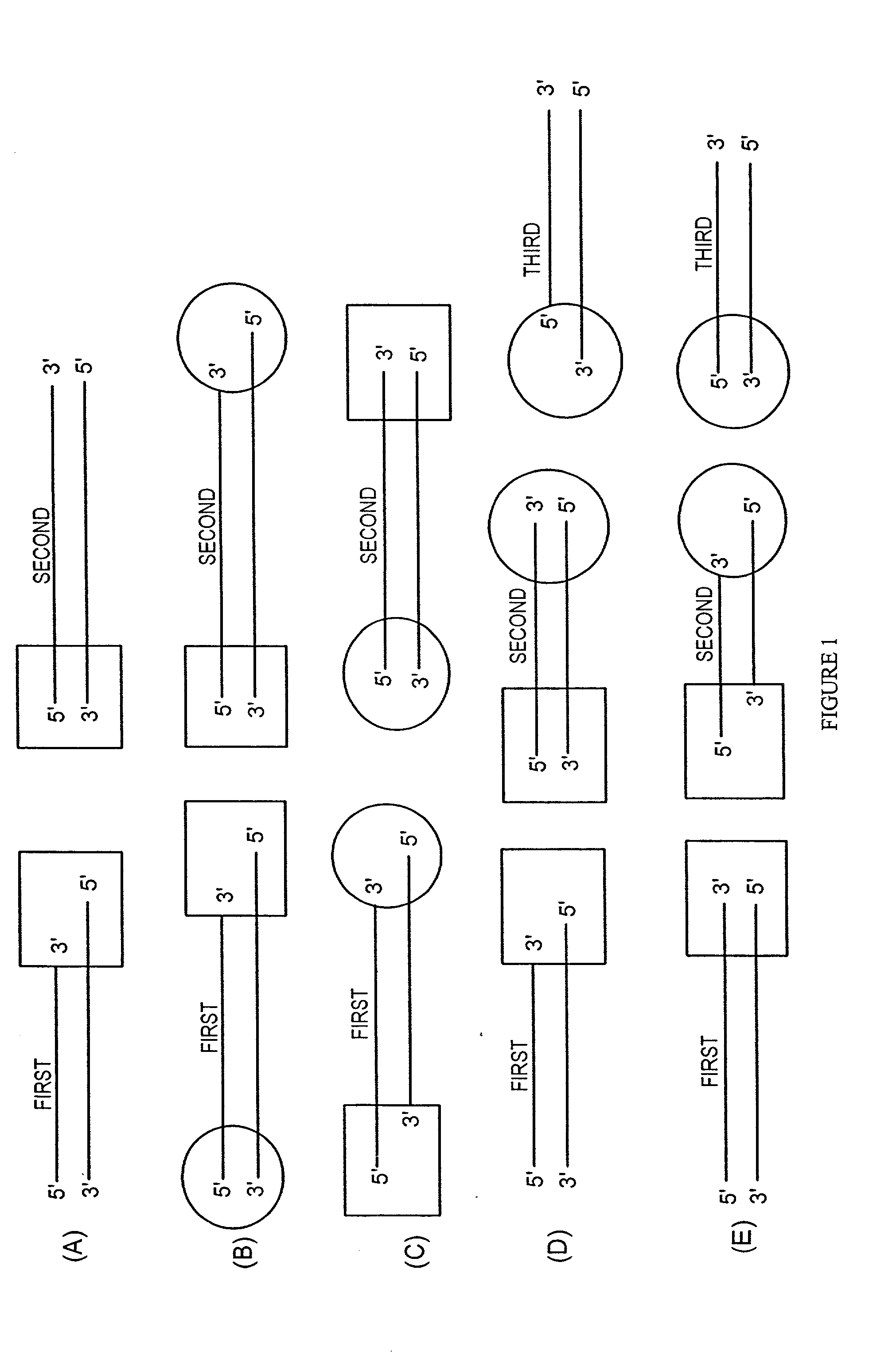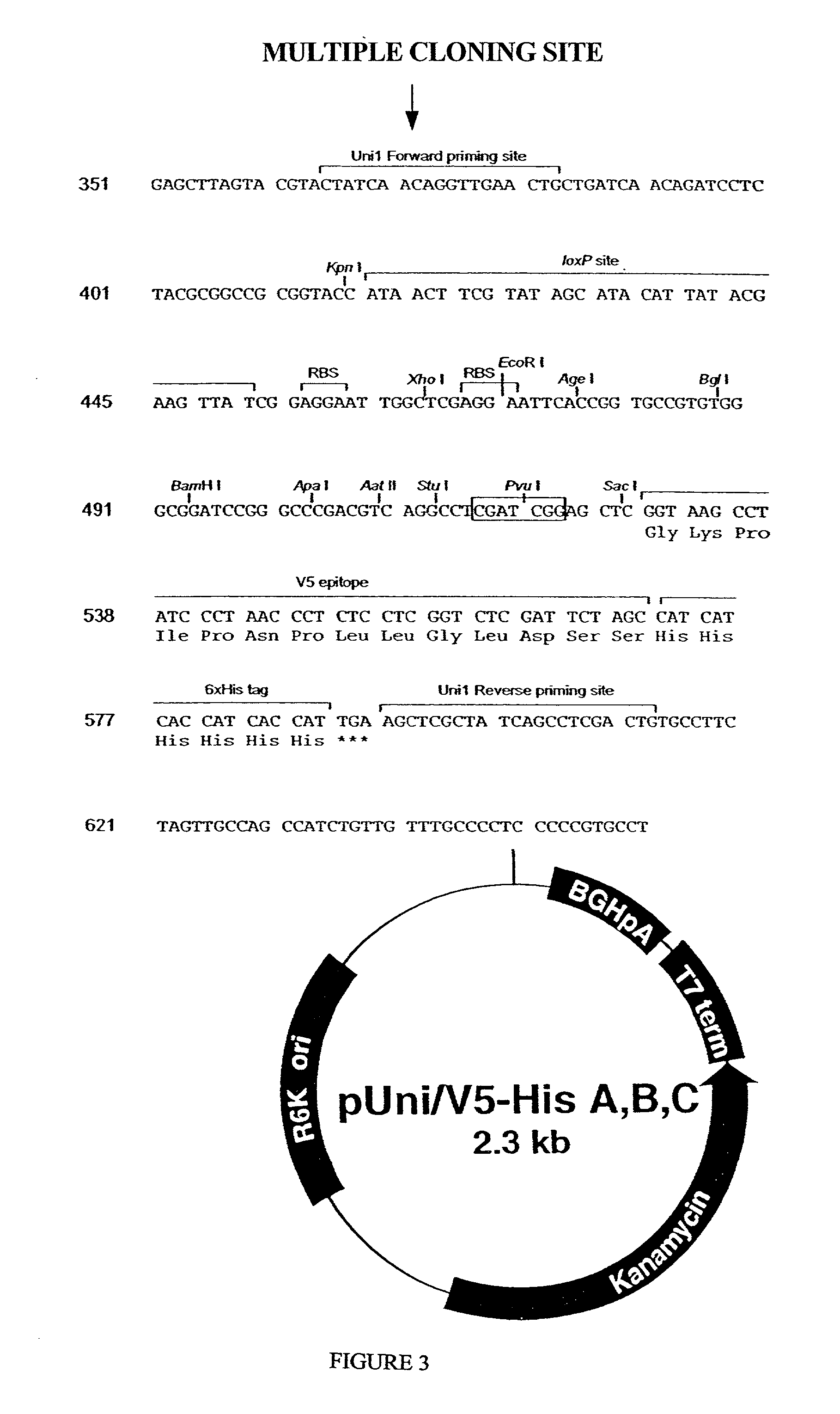Methods and reagents for molecular cloning
a molecular cloning and reagent technology, applied in the field of methods and reagents for molecular cloning, can solve the problems of more difficult undertaking to characterize the regulatory elements involved in the expression of such sequences and to properly express, random orientation of inserts obtained using such cloning methods, and investment of tim
- Summary
- Abstract
- Description
- Claims
- Application Information
AI Technical Summary
Benefits of technology
Problems solved by technology
Method used
Image
Examples
example 2
[0187] As an example of the application of the present invention to another plasmid, pCR.RTM. 2.1, (FIGS. 4 and 12), was modified to create a topoisomerase I adapted vector with a custom single stranded sequence.
[0188] The pCR.RTM. 2.1 plasmid is 3.9 kb T / A cloning vector. Within the sequence of this vector are many uniquely designed elements. These elements include an f1 origin, a ColE1 origin, a kanamycin resistance gene, an ampicillin resistance gene, a LacZ-alpha fragment and a multiple cloning sequence located within the LacZ-alpha fragment allowing for blue-white selection of recombinant plasmids. The multiple cloning sequence, (FIG. 4) of the pCR.RTM. 2.1 plasmid contains; numerous restriction sites, including but not limited to, HindIII, SpeI and EcoRI; M13 forward and reverse primers and a T7 RNA polymerase promoter.
[0189] Construction of the topoisomerase I charged vector possessing a custom single stranded sequence consists of endonuclease digestion followed by complement...
embodiment 5
[0191] The first adapter oligonucleotide, (TOPO H), has complementation to the HindIII cohesive end, 3'-TCGA-5'. Furthermore, TOPO H has an additional 24 bp including the topoisomerase consensus pentapyrimidine element 5'-CCCTT located 19 bp upstream of the 3' end. The remaining sequence and size of TOPO H adapter oligo is variable, and can be modified to fit a researcher's particular needs. In the current embodiment 5'-AGCTCGCCCTTATTCCGATAGTG-3' (SEQ ID NO: 11) is the full sequence of the adapter used.
[0192] The second adapter oligonucleotide, (TOPO 16), must have full complementation to TOPO H. TOPO 16 complements directly 5' of the HindIII cohesive end, extending the bottom strand of the linearized vector. Additionally, TOPO 16 contains the sequence 3'-TAAG, which is the chosen single stranded sequence for directional cloning. The complete sequence of TOPO 16 is 3'-GCGGGAATAAG-5', (SEQ ID NO: 12).
[0193] The third adapter oligonucleotide, (TOPO 1), has complementation to the EcoRI...
example 3
[0202] The present invention is particularly useful in the directional insertion of PCR products into vectors constructed according to the present invention. In the PCR amplification of the desired insert, the PCR primers are designed so as to complement identified sequences of the insert(s) that are to be directionally cloned into the topoisomerase-charged ds nucleic acid vector of the present invention. The primer designed to bind upstream of the DNA's coding strand is modified with an additional complementary nucleotide sequence on its 5' end. The resulting PCR product will possess a complementary sequence allowing single stranded overhang mediated directional insertion into the topoisomerase-charged ds nucleic acid cloning vector of the present invention and subsequent expression of the product.
[0203] One embodiment comprises introducing to a donor duplex DNA substrate a single stranded overhang site by PCR amplifying the donor duplex DNA molecule with the 5' oligonucleotide pri...
PUM
| Property | Measurement | Unit |
|---|---|---|
| Fraction | aaaaa | aaaaa |
| Fraction | aaaaa | aaaaa |
Abstract
Description
Claims
Application Information
 Login to View More
Login to View More - R&D
- Intellectual Property
- Life Sciences
- Materials
- Tech Scout
- Unparalleled Data Quality
- Higher Quality Content
- 60% Fewer Hallucinations
Browse by: Latest US Patents, China's latest patents, Technical Efficacy Thesaurus, Application Domain, Technology Topic, Popular Technical Reports.
© 2025 PatSnap. All rights reserved.Legal|Privacy policy|Modern Slavery Act Transparency Statement|Sitemap|About US| Contact US: help@patsnap.com



